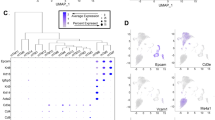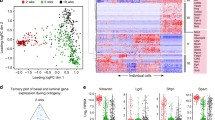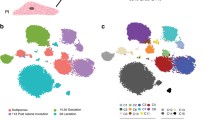Abstract
Mammary epithelial cells (MEC) undergo a series of developmental decisions during a pregnancy cycle. The switches from proliferation to differentiation to secretion and then to cell death are precisely controlled. In order to identify critical changes associated with the transition from a secretory phenotype during lactation to dedifferentiation and cell death, we have undertaken a microarray analysis of mouse mammary gland development. We have focused on the involution switch and on the transcription profiles of genes that are targets of transcription factors known to influence involution and apoptosis. Our results show that both Stat3 and NF-kB target genes are induced by the involution switch while Stat5 target genes are distinct from Stat3 induced genes. Furthermore, a substantial number of genes that were specifically upregulated at the start of involution are regulators of inflammation and the acute phase response. These results provide a novel insight into the involution process and demonstrate the value of microarray analysis in defining molecular events associated with critical developmental transitions in mammary gland.
Similar content being viewed by others
REFERENCES
S. R. Master, J. L. Hartman, C. M. D'Cruz, S. E. Moody, E. A. Keiper, S. I. Ha, J. D. Cox, G. K. Belka, and L. A. Chodosh (2002). Functional microarray analysis of mammary organogenesis reveals a developmental role in adaptive thermogenesis. Mol. Endocrinol. 16:1185–1203.
P. F. Lemkin, G. C. Thornwall, K. D. Walton, and L. Hennighausen (2000). The microarray explorer tool for data mining of cDNA microarrays: Application for the mammary gland. Nucleic Acids Res. 28:4452–4459.
T. L. Phang, M. C. Neville, M. Rudolph, and L. Hunter (2003). Trajectory clustering: A non-parametric method for grouping gene expression time courses, with applications to mammary development. Pac. Symp. Biocomput. 351–362.
M. Lee, H. Kim, D. Jeon, I. Hwang, B. Choi, K. Myung, Y. Choi, S. Paik, and M. Baik (1996). Iron metabolism-related genes and mitochondrial genes are induced during involution of mouse mammary gland. Biochem. Biophys. Res. Commun. 224:164–168.
R. Strange, F. Li, S. Saurer, A. Burkhardt, and R. R. Friis (1992). Apoptotic cell death and tissue remodeling during mouse mammary gland involution. Development 115:49–58.
R. S. Chapman, P. C. Lourenco, E. Tonner, D. J. Flint, S. Selbert, K. Takeda, S. Akira, A. R. Clarke, and C. J. Watson (1999). Suppression of epithelial apoptosis and delayed mammary gland involution in mice with a conditional knockout of Stat3. Genes Dev. 13:2604–2616.
X. Liu, G. W. Robinson, K. U. Wagner, L. Garrett, A. Wynshaw-Boris, and L. Hennighausen (1997). Stat5a is mandatory for adult mammary gland development and lactogenesis. Genes Dev. 11:179–186.
H. Yamashita, H. Iwase, T. Toyama, and Y. Fujii (2003). Naturally occurring dominant-negative Stat5 suppresses transcriptional activity of estrogen receptors and induces apoptosis in T47D breast cancer cells. Oncogene 22:1638–1652.
R. S. Chapman, E. K. Duff, P. C. Lourenco, E. Tonner, D. J. Flint, A. R. Clarke, and C. J. Watson (2000). A novel role for IRF-1 as a suppressor of apoptosis. Oncogene 19:6386–6391.
D. J. Jerry, J. Pinkas, C. Kuperwasser, E. S. Dickinson, and S. P. Naber (1999). Regulation of p53 and its targets during involution of the mammary gland. J. Mammary Gland Biol. Neoplasia 4:177–181.
D. J. Jerry, E. S. Dickinson, A. L. Roberts, and T. K. Said (2002). Regulation of apoptosis during mammary involution by the p53 tumor suppressor gene. J. Dairy Sci. 85:1103–1110.
R. W. Clarkson, J. L. Heeley, R. Chapman, F. Aillet, R. T. Hay, A. Wyllie, and C.J. Watson (2000). NF-kappaB inhibits apoptosis in murine mammary epithelia. J. Biol. Chem. 275:12737–12742.
S. Geymayer and W. Doppler (2000). Activation of NF-kappaB p50/p65 is regulated in the developing mammary gland and inhibits STAT5-mediated beta-casein gene expression. FASEB. J. 14:1159–1170.
Y. A. Yang, B. Tang, G. Robinson, L. Hennighausen, S. G. Brodie, C. X. Deng, and L. M. Wakefield (2002). Smad3 in the mammary epithelium has a nonredundant role in the induction of apoptosis, but not in the regulation of proliferation or differentiation by transforming growth factor-beta. Cell Growth Differ. 13:123–130.
R. Kane, D. Finlay, T. Lamb, and F. Martin (2000). Transcription factor NF 1 expression in involuting mammary gland. Adv. Exp. Med. Biol. 480:117–122.
A. Marti, H. Lazar, P. Ritter, and R. Jaggi (1999). Transcription factor activities and gene expression during mouse mammary gland involution. J. Mam. Gland Biol. Neoplasia 4:145–152.
A. Marti, B. Jehn, E. Costello, N. Keon, G. Ke, F. Martin, and R. Jaggi (1994). Protein kinase A and AP-1 (c-Fos/JunD) are induced during apoptosis of mouse mammary epithelial cells. Oncogene 9:1213–1223.
R. Neve, C. H. Chang, G. K. Scott, A. Wong, R. R. Friis, N. E. Hynes, and C. C. Benz (1998): The epithelium-specific ets transcription factor ESX is associated with mammary gland development and involution. FASEB J. 12:1541–1550.
Y. Friedmann and C. W. Daniel (1996). Regulated expression of homeobox genes Msx-1 and Msx-2 in mouse mammary gland development suggests a role in hormone action and epithelial-stromal interactions. Dev. Biol. 177:347–355.
E. Iavnilovitch, B. Groner, and I. Barash (2002). Overexpression and forced activation of stat5 in mammary gland of transgenic mice promotes cellular proliferation, enhances differentiation, and delays postlactational apoptosis. Mol. Cancer Res. 1:32–47.
J. Y. Yoo, D. L. Huso, D. Nathans, and S. Desiderio (2002). Specific ablation of Stat3beta distorts the pattern of Stat3-responsive gene expression and impairs recovery from endotoxic shock. Cell 108:331–344.
D. K. Biswas, K. J. Martin, C. McAlister, A. P. Cruz, E. Graner, S. C. Dai, and A. B. Pardee (2003): Apoptosis caused by chemotherapeutic inhibition of nuclear factor-kappaB activation. Cancer Res. 63:290–295.
K. Hinata, A. M. Gervin, Y. Jennifer Zhang, and P. A. Khavari (2003). Divergent gene regulation and growth effects by NF-kappa B in epithelial and mesenchymal cells of human skin. Oncogene 22:1955–1964.
J. Khan, M. L. Bittner, L. H. Saal, U. Teichmann, D. O. Azorsa, G. C. Gooden, W. J. Pavan, J. M. Trent, and P. S. Meltzer (1999). cDNA microarrays detect activation of a myogenic transcription program by the PAX3-FKHR fusion oncogene. Proc. Natl. Acad. Sci. U. S. A. 96:13264–13269.
E. A. Kritikou, A. Sharkey, K. Abell, P. J. Came, E. Anderson, R. W. Clarkson, and C. J. Watson (2003). A dual, non-redundant, role for LIF as a regulator of development and STAT3-mediated cell death in mammary gland. Development 130:3459–3468.
K. E. Gordon, B. Binas, R. S. Chapman, K. M. Kurian, R. W. Clarkson, A. J. Clark, E. B. Lane, and C. J. Watson (2000). A novel cell culture model for studying differentiation and apoptosis in the mouse mammary gland. Breast Cancer Res. 2:222–235.
A. M. O'Farrell, D. A. Parry, F. Zindy, M. F. Roussel, E. Lees, K. W. Moore, and A. L. Mui (2000). Stat3-dependent induction of p19INK4D by IL-10 contributes to inhibition of macrophage proliferation. J. Immunol. 164:4607–4615.
C. Li and W. H. Wong (2001). Model-based analysis of oligonucleotide arrays: Expression index computation and outlier detection. Proc. Natl. Acad. Sci. U. S. A. 98:31–36.
G. Li, G. W. Robinson, R. Lesche, H. Martinez-Diaz, Z. Jiang, N. Rozengurt, K. U. Wagner, D. C. Wu, T. F. Lane, X. Liu, L. Hennighausen, and H. Wu (2002). Conditional loss of PTEN leads to precocious development and neoplasia in the mammary gland. Development 129:4159–4170.
Y. Cao, G. Bonizzi, T. N. Seagroves, F. R. Greten, R. Johnson, E. V. Schmidt, and M. Karin (2001). IKKalpha provides an essential link between RANK signaling and cyclin D1 expression during mammary gland development. Cell 107:763–775.
L. R. Lund, J. Romer, N. Thomasset, H. Solberg, C. Pyke, M. J. Bissell, K. Dano, and Z. Werb (1996). Two distinct phases of apoptosis in mammary gland involution: Proteinase-independent and-dependent pathways. Development 122:181–193.
E. Marshman, K. A. Green, D. J. Flint, A. White, C. H. Streuli, and M. Westwood (2003). Insulin-like growth factor binding protein 5 and apoptosis in mammary epithelial cells. J. Cell Sci. 116:675–682.
M. Kannius-Janson, U. Lidberg, K. Hulten, A. Gritli-Linde, G. Bjursell, and J. Nilsson (1998). Studies of the regulation of the mouse carboxyl ester lipase gene in mammary gland. Biochem. J. 336(Pt3):577–585.
J. Monks, F. J. Geske, L. Lehman, and V. A. Fadok (2002). Do inflammatory cells participate in mammary gland involution? J. Mam. Gland Biol. Neoplasia 7:163–176.
V. Poli (1998). The role of C/EBP isoforms in the control of inflammatory and native immunity functions. J. Biol. Chem. 273:29279–29282.
Author information
Authors and Affiliations
Corresponding author
Rights and permissions
About this article
Cite this article
Clarkson, R.W.E., Watson, C.J. Microarray Analysis of the Involution Switch. J Mammary Gland Biol Neoplasia 8, 309–319 (2003). https://doi.org/10.1023/B:JOMG.0000010031.53310.92
Issue Date:
DOI: https://doi.org/10.1023/B:JOMG.0000010031.53310.92




